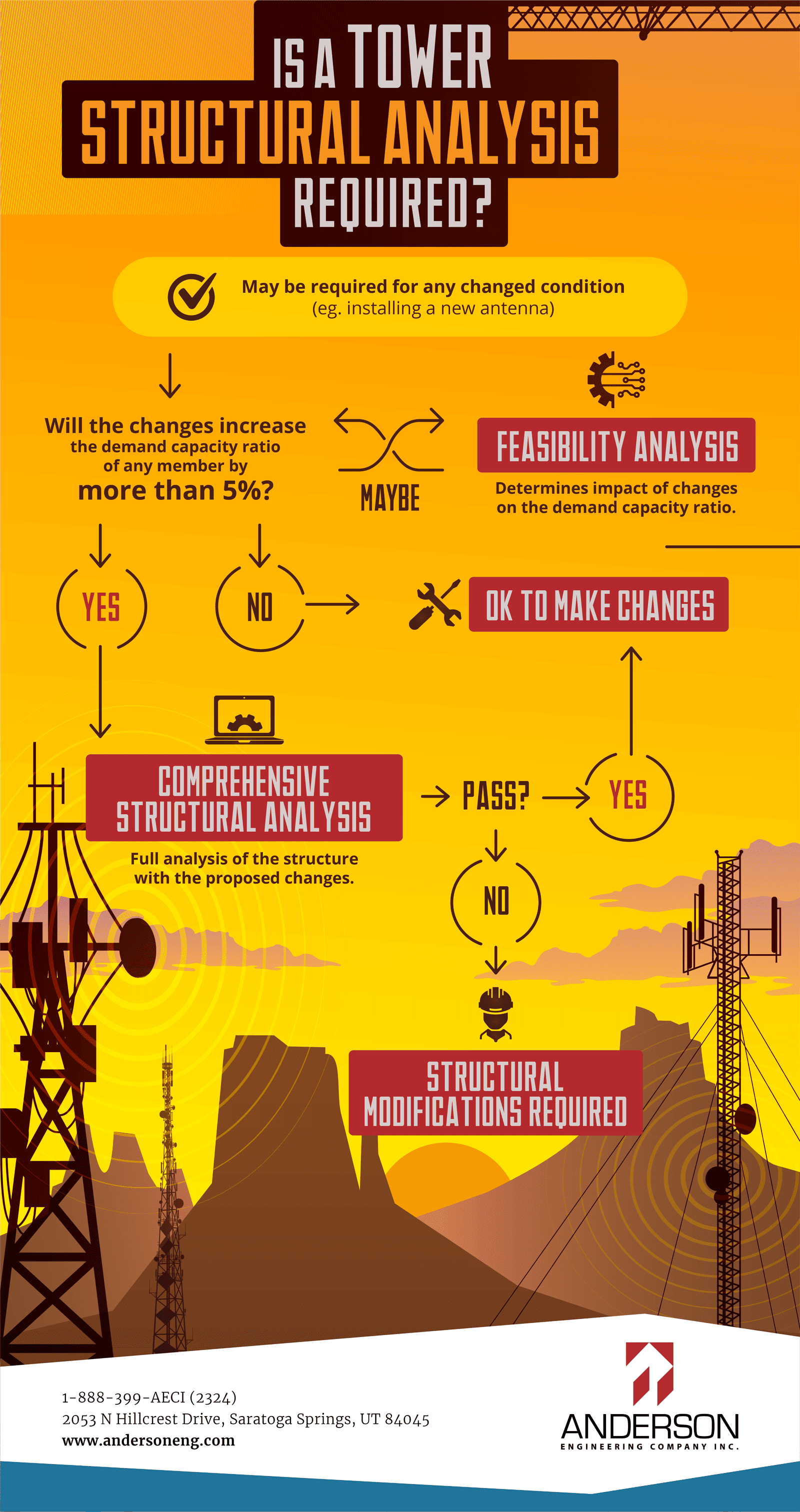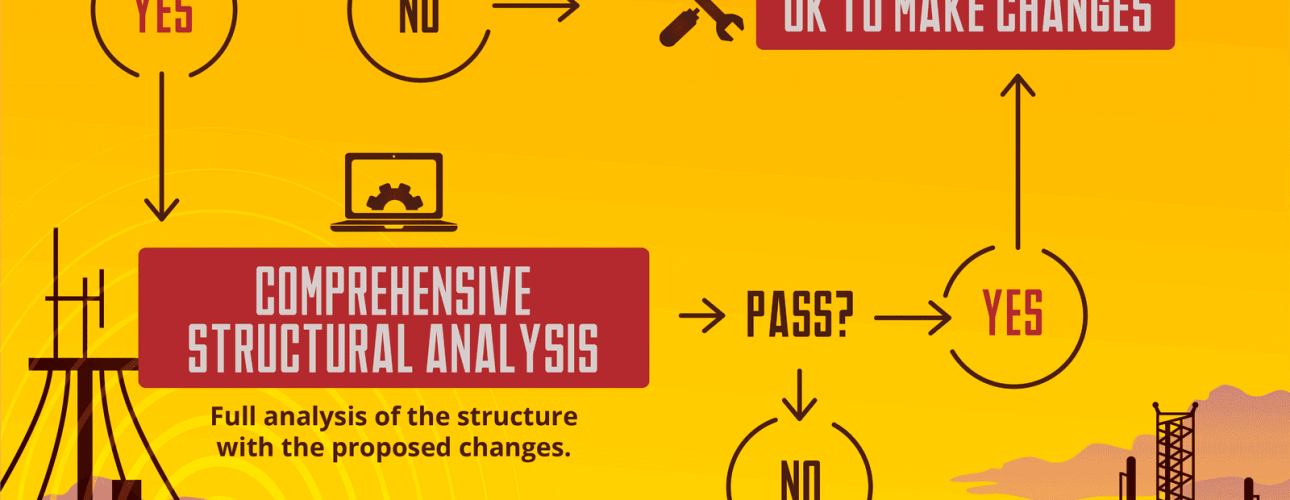Introduction
Traffic growth on wireless broadband networks is exploding. Carriers are struggling to keep up with the increased traffic while creating new plans to attract users to consume more data. To keep up with this demand they are deploying more equipment than ever including fifth-generation (5G) technology to keep up.
Supporting this advanced technology are telecommunication structures or cell towers. Cell towers are the backbone of the wireless telecommunication network. They can’t fail– the technology demands reliability. Yet, for cell sites to function best, we often have to build them in hostile locations; subject to extreme wind forces, ice, and earthquakes. It doesn’t help that many of our towers were not designed for today’s larger equipment.
You wouldn’t think twice about adding a new desk to an office if there was room for it. Buildings have fairly standard design loading requirements. Towers and rooftops, however? They’re different. Engineers design them based on what the anticipated equipment is at the time. This is a problem for cell towers since towers outlive the technology they support.
The wind is typically the force with the most impact on a cell tower. Thus, even small antennas act like sails to pull the tower down. It’s crucial to engineer all changes to a tower or its equipment.
To ensure our communications remain reliable, the Telecommunications Industry Association (TIA-222) has established standards and codes for antenna supporting structures.

When is a telecommunications engineering structural analysis required for a cell tower?
The International Building Code (IBC 2018) requires that towers are designed following the provisions of TIA-222. The latest TIA-222 standard (Revision H) was published in 2018. It provides guidelines on if a structural analysis on a cell tower is required.
Essentially, if anything is changing on the tower such as equipment, risk category, serviceability requirements, or structural changes, you may need a structural analysis; including changes to self-supporting, guyed, and monopole towers. And the requirement applies to other cell sites such as rooftop skids, wall-mounted antennas, water towers, and other antenna supporting structures.
So how do you determine if a cell tower structural analysis is necessary?
Revision H requires a structural analysis when the demand-capacity ratio of any member will increase by 5%. Or, if the expected loads are within the baseline loading of the tower.
Is the Demand-Capacity Ratio increasing by more than 5% on any members?
The demand-capacity ratio is the ratio of the required strength of a component to the design strength of a component. For example, let’s say a tower member strong enough to support 1000 pounds currently supports 100 pounds. The demand capacity ratio for this component would be 10%. Now you are adding a new antenna and the load of the horizontal member increases by 100 pounds. The demand capacity ratio of that component has increased by 10% to 20%. This seemingly small change on a large cell tower is enough to warrant a comprehensive structural analysis.
How do the proposed changes compare to the Baseline Appurtenance Loading?
The baseline tower loads are the loads that the fabricator designed the tower for. For example, if you are building a new tower, the fabricator may ask: What do you plan to put on this tower? What do you plan to put on in the future? Where are you erecting the tower?
The fabricator designs the tower and foundation to support the antennas, dishes, cables, in the specific location you are placing the tower. So if your tower is on top of a mountain, the fabricator accounts for the wind, ice, and seismic loads of the area. If the tower supports your radio equipment it doesn’t need to be as tough as a tower relied upon for police emergency communications. The fabricator takes all this into account and creates the planned loading known as Baseline Appurtenance Loading.
When you are changing equipment on the tower, and the changes are within the baseline loading, then a structural analysis isn’t required. Using the example above, if the tower member was expected to have a demand-capacity ratio of 90%, but the actual ratio was only 10%, than an increase to 15% wouldn’t require an analysis since it is well below the baseline loading design capacity ratio.
Typically some type of analysis is needed to evaluate the proposed changes
Here is where it gets tricky. It’s not always clear when the demand capacity ratio is increasing or by how much. Nor do today’s modern equipment resemble equipment found in many tower baseline loading scenarios. Also, if the tower has had structural upgrades, the baseline loading no longer applies.
Another challenge is that most towers have equipment from multiple carriers, and each of these carriers makes changes without notifying the others. While each incremental change may be small, you need to consider all changes to comply with Revision H. This creates two potential pathways — a feasibility study and if necessary, a comprehensive structural analysis.
The code provides a pathway to help you prevent unnecessary analysis
Feasibility Study
A feasibility study is a preliminary analysis of an existing cell tower. The objective is to evaluate if the proposed condition will increase the demand-capacity ratio of any structural member.
A feasibility study first looks to see if the changes are within baseline loading. If not, an analysis is done to ensure that the demand capacity ratio of any member hasn’t increased by 5%. If either of these are valid, you can move forward with the proposed equipment changes.
The feasibility analysis is much simpler in scope and may be worth pursuing if the change seems small.
Comprehensive Structural Analysis
If the feasibility study determines that your tower needs to have additional analysis than a comprehensive structural analysis is the next step. This study looks at every part of the tower, including structural members, connections, anchorages, and foundations. If the comprehensive analysis determines the tower to be over capacity, the engineer will recommend tower modifications before changing equipment.
What data do you need to complete a structural analysis?
To perform either the feasibility analysis or the comprehensive structural analysis, you will need to provide up-to-date information on the tower. Data may include a previous structural analysis, installation documents, fabrication drawings, geotechnical reports, and past upgrade drawings. Based on the provided data, the engineer may need to perform on-site field mapping and measurements of the tower, appurtenances, and foundation.
The structural telecommunications engineer aggregates this data to create a structural model of the tower. This model is used to evaluate the telecommunications tower with the proposed equipment. The analysis looks at all types of scenarios involving wind, ice, snow, dead, and seismic loads.
Once the engineer has created the model, they can quickly evaluate all future changes according to code to determine if they will need to do a full analysis or structural modifications.
Conclusion
Telecommunications and cell towers are complicated structures. Something as simple as adding an antenna or transmission line to a tower may have unforeseen impacts. TIA-222-H provides detailed guidance on when a structural analysis is necessary. These guidelines ensure that the tower can safely support the wireless infrastructure and provide reliable communications. If you are planning an upgrade to a cell tower, ensure that proper engineering is completed to make sure the tower can maintain the reliability required by the equipment. Keeping an accurate model of a tower with up-to-date data makes future upgrades easier to manage.





